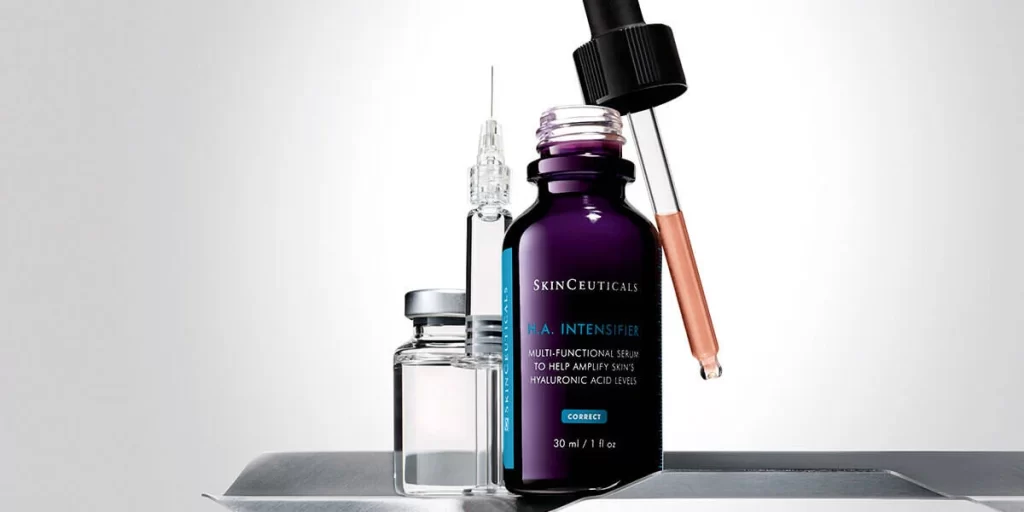Understanding Dermal Fillers
Definition and Use
Dermal fillers are substances injected into the skin. They primarily enhance facial features and reduce signs of aging. People use dermal filler injections to smooth wrinkles, add volume, and improve facial contours.
Materials Used
Various materials are used in dermal fillers. Hyaluronic acid dermal fillers are popular because they are naturally found in the body. Other options include calcium hydroxylapatite, poly-L-lactic acid, and polymethylmethacrylate beads. Each material offers different benefits and durations.
Natural vs Synthetic Options
Natural options like hyaluronic acid fillers integrate well with the body’s tissues. Synthetic options may last longer but can have a higher risk of complications. It’s important to understand the differences before choosing.
Consulting Healthcare Professionals
Consulting with healthcare professionals is crucial. They provide personalized treatment plans tailored to individual needs. They assess the skin type, medical history, and desired outcomes.
Personalized Treatment Plans
Healthcare professionals use various dermal filler techniques based on the patient’s requirements. This ensures safe and effective results. Proper consultation helps in selecting the right dermal filler product.
Importance of Expertise
Expertise in applying dermal fillers minimizes risks and enhances results. Trained professionals know how to manage potential side effects and complications.
Common Side Effects
Swelling and Redness
Swelling is a common side effect after getting dermal fillers. It usually occurs around the injection site. Most people experience this within a few hours post-injection. Redness often accompanies swelling, making the treated area look inflamed. Both of these effects are temporary. They typically resolve within a few days to weeks.
Bruising
Bruising can also happen after receiving dermal fillers. This occurs because the needle can damage small blood vessels under the skin. The bruises might appear as dark spots or patches. These marks usually fade away within a week or two. Applying ice packs can help reduce bruising.
Pain and Tenderness
Pain and tenderness at the injection site are other common side effects. This discomfort can range from mild to moderate. It may last for a few days post-treatment. The pain can make it hard to perform daily activities, like chewing or smiling, if the filler was injected near the mouth.
Itching
e individuals may experience itching at the injection site. This sensation is usually mild but can be annoying. Itching often subsides within a few days. Avoid scratching the area to prevent irritation or infection.
Allergic Reactions
Allergic reactions to dermal fillers are rare but possible. Signs of an allergic reaction include severe swelling, redness, and itching. In extreme cases, difficulty breathing may occur. Seek medical attention immediately if you suspect an allergic reaction.
Lumps and Bumps
Lumps and bumps can form under the skin after filler injections. This happens when the filler material clumps together. These lumps are usually temporary and dissolve on their own over time. Massaging the area gently can help smooth out these irregularities.
Infection
Infection is a less common but serious side effect of dermal fillers. Symptoms include increased redness, swelling, and pain at the injection site. If you notice any pus or fever, consult your doctor right away. Proper sterilization techniques during the procedure can minimize this risk.
Temporary Loss of Sensation
Temporary loss of sensation in the treated area can occur. This numbness is due to nerve irritation from the injection process. Sensation usually returns within a few days to weeks.
Rare Complications
Inflammation
Inflammation is a rare but possible side effect of dermal fillers. It can occur after illnesses, vaccinations, or dental procedures. The skin may become red, swollen, and painful. This reaction can last for days or weeks. Medical attention might be needed if the symptoms persist.
Nodules
Nodules are small lumps that may form under the skin. They can develop weeks or even months after the injection. These nodules might be hard or soft. Some cases require further treatment to dissolve them. Steroid injections or surgery might be necessary.
Granulomas
Granulomas are another type of lump that can form. They result from the body’s immune response to the filler material. These lumps are often firm and can be painful. Granulomas might need medical intervention to remove them. Treatment options include steroids or surgical removal.
Infection
Infection is a serious but rare risk of dermal fillers. Bacteria can enter the injection site, causing redness, swelling, and pain. Infections may lead to abscesses that require drainage. Antibiotics are often prescribed to treat infections.
Allergic Reactions
Allergic reactions to dermal fillers are uncommon but possible. Symptoms include itching, swelling, and redness at the injection site. Severe allergic reactions can cause difficulty breathing and require immediate medical attention.
Tissue Death (Necrosis)
Necrosis is a rare but severe complication of dermal fillers. It occurs when blood flow is blocked to an area of tissue, causing it to die. This can happen if the filler is injected into a blood vessel by mistake. Skin necrosis results in pain and discoloration of the affected area.
Unintended Injection
Unintended injection into blood vessels can cause serious problems. It may lead to skin complications like necrosis or even blindness if it affects the eyes. Immediate treatment is crucial to minimize damage.
Bruising
Bruising is another rare complication but can be severe in some cases. It happens when blood vessels are damaged during the injection process. Large bruises may take weeks to heal and could require medical attention.
Pre-Procedure Precautions
Medical History
Disclose your full medical history to your healthcare provider. This includes any past surgeries, allergies, and chronic conditions. Knowing your medical background helps the provider assess potential risks. For instance, if you have a history of severe allergies, it may affect the choice of dermal fillers.
Current Medications
Inform the provider about all medications you are currently taking. This includes prescription drugs, over-the-counter medications, and supplements. Certain medications can increase the risk of adverse reactions during cosmetic procedures. Blood thinners like aspirin can cause excessive bruising.
Qualified Provider
Consult with a qualified healthcare provider before undergoing any procedure. Choose a licensed professional with experience in administering dermal fillers. They can explain both the benefits and risks involved. A skilled provider minimizes complications by using proper techniques.
Avoid Certain Medications
Stop taking certain medications and supplements before the procedure to reduce risks. Avoid blood-thinning medications like aspirin and ibuprofen at least two weeks prior. These can increase bruising and bleeding. Also, avoid vitamin E and fish oil supplements as they have similar effects.
Informed Consent
Before proceeding with dermal fillers, ensure you sign an informed consent form. This document outlines the potential risks and benefits of the procedure. It also confirms that you understand these aspects fully. Signing this form is crucial for legal and ethical reasons.
Skin Assessment
A thorough skin assessment should be conducted before the procedure. The healthcare provider will examine your skin type and condition. This helps in selecting the most suitable filler type. Certain skin conditions like acne or eczema may require special considerations.
Allergic Reactions
Discuss any known allergies with your provider to prevent allergic reactions. Some dermal fillers contain substances that could trigger allergies. For example, fillers made from animal products may not be suitable for everyone.
Treatment Plan
Develop a comprehensive treatment plan with your provider. This plan should outline the areas to be treated, the type of filler to be used, and the expected outcomes. A clear treatment plan ensures that both you and your provider are on the same page.
Post-Treatment Care
Ice Application
Applying ice to the treated area can reduce swelling. Use an ice pack wrapped in a cloth. Apply it gently for 15-20 minutes. Repeat this process every few hours on the first day.
Avoid applying ice directly to the skin. Direct contact can cause frostbite. Always use a barrier like a cloth or towel.
Activity Restrictions
Avoid strenuous activities for at least 24-48 hours after the injection. Exercise and heavy lifting can increase blood flow, leading to more swelling and bruising.
Rest is crucial for recovery. Strenuous activities can also raise blood pressure, which may worsen side effects.
Follow Provider Instructions
Follow your healthcare provider’s instructions carefully. They know your specific case and will give personalized advice.
Ignoring these instructions can lead to complications. Providers often recommend avoiding certain medications that thin the blood, like aspirin, before and after treatment.
Signs of Complications
Watch for signs of complications. Unusual pain, severe swelling, or skin discoloration are red flags.
If you notice any of these symptoms, contact your health care provider immediately. Early intervention can prevent more serious issues.
Avoid Certain Products
Avoid using products with harsh chemicals on the treated area. This includes strong cleansers and exfoliants.
These products can irritate the skin further and delay healing. Stick to gentle skincare products as recommended by your provider.
Stay Hydrated
Drink plenty of water after your treatment. Staying hydrated helps your body heal faster.
Water aids in flushing out toxins and keeps your skin healthy. Hydration is key for maintaining overall skin health post-treatment.
Safety Tips for Consumers
Avoid Self-Injection
Never purchase dermal fillers online. These products can be counterfeit or unsafe. Attempting self-injection poses serious risks. Complications include infections, allergic reactions, and unsatisfactory results.
Self-injection can also cause uneven distribution of the filler. This leads to lumps or asymmetry in the face. Always seek professional help.
Choose Licensed Providers
Only let experienced and licensed healthcare providers perform injections. They know how to handle the materials safely. They also understand facial anatomy well.
Licensed providers use sterile techniques. This reduces the risk of infections. They can also manage any complications that arise during the procedure.
Understand the Product
Know the specific product being used. Different fillers have different uses and side effects. Some are for wrinkles, while others add volume to lips or cheeks.
Ask about the ingredients in the filler. Some materials may not be suitable for everyone. Understand potential side effects like swelling, bruising, or redness.
Be Aware of Risks
All medical procedures come with risks. Dermal fillers can cause side effects like:
-
Swelling
-
Bruising
-
Redness
-
Infection
In rare cases, more severe complications occur. These include vascular occlusion, which can lead to tissue death if untreated.
Follow Post-Treatment Care
Proper post-treatment care is crucial for safety. Follow all instructions given by your provider. This helps minimize risks and ensures better results.
Avoid touching or massaging treated areas unless advised otherwise. Doing so can move the filler and affect results.
Report Any Issues
If you experience unusual symptoms after treatment, contact your provider immediately. Early intervention can prevent serious complications.
Alternatives to Fillers
Topical Treatments
Topical treatments offer a non-invasive option for those hesitant about filler injections. These products include creams, serums, and lotions that contain active ingredients like retinoids, hyaluronic acid, and peptides. Retinoids help increase cell turnover, which can reduce wrinkles over time. Hyaluronic acid attracts moisture to the skin, making it appear plumper and more hydrated.
Peptides stimulate collagen production. Collagen is essential for maintaining skin elasticity and firmness. Using these topical treatments consistently can lead to noticeable improvements in skin texture and appearance.
Botox
Botox is another popular alternative to dermal fillers. Unlike cosmetic fillers, Botox works by temporarily paralyzing the muscles that cause wrinkles. This makes it effective for treating dynamic wrinkles, such as crow’s feet and forehead lines. The effects of Botox typically last three to six months.

Botox is administered through injections but involves less downtime compared to some filler procedures. It has been widely used for decades and is FDA-approved for various cosmetic applications.
Laser Treatments
Laser treatments are another viable option for those looking to avoid injectable fillers. These treatments use focused light energy to target specific skin concerns, like wrinkles, scars, and pigmentation issues. There are different types of lasers, including ablative and non-ablative lasers.
Ablative lasers remove the outer layer of skin, promoting new skin growth. Non-ablative lasers work beneath the surface without damaging the top layer. Both types can stimulate collagen production, improving skin tone and texture over time.
Lifestyle Changes
Lifestyle changes can naturally enhance skin health and appearance. A balanced diet rich in vitamins and minerals supports overall skin health. Foods high in antioxidants, like fruits and vegetables, can protect the skin from damage caused by free radicals.
Regular exercise improves blood circulation, which helps nourish skin cells. Hydration is also crucial; drinking plenty of water keeps the skin hydrated from within.
Skincare Routines
A consistent skincare routine can also serve as an alternative to injectable drugs like dermal fillers. Cleansing removes dirt and oil that can clog pores and cause breakouts. Exfoliating helps remove dead skin cells, revealing fresher skin underneath.
Moisturizing maintains the skin’s hydration levels, preventing dryness and flakiness. Sunscreen protects against UV damage, which accelerates aging and increases the risk of skin cancer.
Making Informed Decisions
Research First
People should gather information before deciding on dermal fillers. Various studies and clinical trials provide valuable insights. These resources can help understand the potential side effects. Reading up-to-date research ensures you are aware of the latest findings.
Consulting with a healthcare professional is crucial. They can offer personalized advice based on your medical history. This step helps avoid unexpected complications.
Weighing Benefits and Risks
Dermal fillers can improve appearance by reducing lines and crow’s feet. However, there are risks involved. Some people may experience swelling or bruising. In rare cases, more severe reactions can occur.
Consider your health conditions before proceeding. For example, people with allergies might face higher risks. Discuss these factors with your doctor to make an informed choice.
Reflect on Motivations
Understanding why you want dermal fillers is important. Are you looking to enhance your appearance for a special event? Or do you seek long-term changes? Reflecting on your motivations helps set realistic expectations.
Many seek dermal fillers to combat signs of age. It’s essential to have a clear vision of the results you desire. Setting realistic goals prevents disappointment later on.
Set Realistic Expectations
Expectations should align with what dermal fillers can achieve. Fillers can smooth wrinkles and add volume to certain areas. However, they won’t stop the aging process entirely.
Discuss potential outcomes with your healthcare provider. They can show before-and-after photos from past patients. This gives a clearer idea of what to expect.
Personal Health Conditions
Your overall health plays a role in how well you respond to dermal fillers. Certain conditions may increase risks or affect results. For instance, people with autoimmune diseases need extra caution.
Medical professionals can assess if you’re a good candidate for fillers. Share all relevant health information during consultations.
Closing Thoughts
Understanding dermal fillers and their side effects is crucial for your safety and satisfaction. By knowing both common and rare complications, you can make informed choices and take necessary precautions. Remember, proper pre-procedure and post-treatment care can significantly reduce risks.
We encourage you to weigh all alternatives and follow the safety tips provided. Always consult with a qualified professional before proceeding. Your health and well-being are paramount. Stay informed, stay safe, and enjoy the benefits with confidence. Ready to explore more? Dive deeper into our resources or reach out for expert advice today.
Frequently Asked Questions
What are dermal fillers?
Dermal fillers are injectable substances used to restore volume, smooth wrinkles, and enhance facial contours. They are commonly made from hyaluronic acid.
What are the common side effects of dermal fillers?
Common side effects include redness, swelling, bruising, and tenderness at the injection site. These usually subside within a week.
Are there any rare complications associated with dermal fillers?
Yes, rare complications can include infection, lumps, and vascular occlusion. It’s essential to choose a qualified practitioner to minimize risks.
How should I prepare before getting dermal fillers?
Avoid blood thinners and alcohol for a few days before the procedure. Discuss your medical history with your provider.
What post-treatment care is recommended after getting dermal fillers?
Apply ice to reduce swelling. Avoid strenuous activities and exposure to heat for 24-48 hours post-treatment.
Are there alternatives to dermal fillers?
Yes, alternatives include Botox, laser treatments, and non-invasive skin tightening procedures. Consult with a dermatologist to determine the best option for you.
How can I make an informed decision about dermal fillers?
Research thoroughly, consult with certified professionals, and consider potential risks and benefits. Always prioritize safety over cost.





